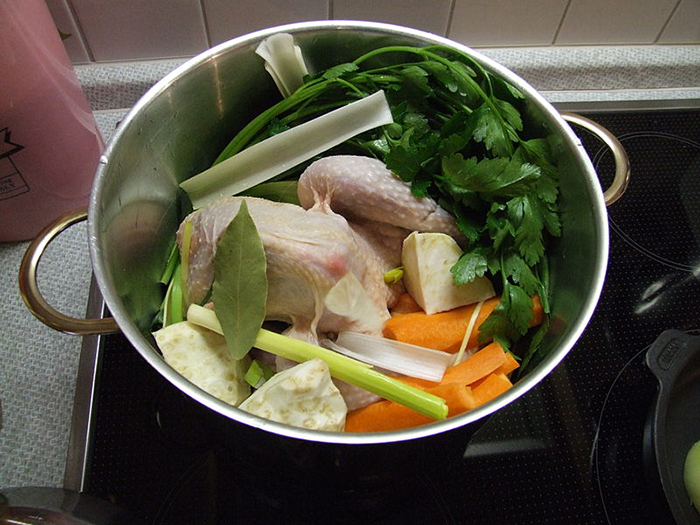I have a cold. I’ll spare you the details of congestion and fatigue and jump to symptom- relieving food. Through the fog of store-bought cold remedies, I’m thinking about the traditional treatment for my complaints – Chicken Soup.
Mothers have treated family colds with chicken soup for generations. Part of the benefit undoubtedly comes from the enveloping aroma of chicken simmering with vegetables that rises from the pot. The hearty chicken vapor wafting up from the bowl as you lean in to take sips helps to clear the the head, just like a steamy shower. Making the soup demonstrates a level of love and affection that also contributes to relief.
In addition to the comfort factor, there may be actual therapeutic value to chicken soup. A study at the University of Nebraska Medical Center in Omaha by Dr. Stephen Rennard shows that the soup has a beneficial effect on infection-fighting white blood cells. Researchers at Mount Sinai Hospital in Miami demonstrated that hot chicken soup was the most effective in a range of options to loosen head congestion. Any list of cold treatments encourages lots of fluids, which includes soups. I don’t think chicken soup will cure my cold, but the mix of chicken, vegetables, hot broth and soothing flavors can’t hurt and may help.
I’ll confess that I didn’t like the chicken soup of my childhood. Made by my mother in a loving tradition, it was really just boiled chicken and didn’t appeal to my young and cold-impaired taste buds. As an adult, I’ve come to enjoy chicken soup in its many variations while either healthy or under the weather.
Chicken soup is found worldwide in any culture where flocks are kept. While it includes local flavoring and spice traditions, the basis is always chicken simmered long and slow to yield a rich and nourishing broth.
A quick survey of classic cookbooks by Julia Child, James Beard and Fannie Farmer did not turn up lots of basic chicken-vegetable soup recipes. It seems this dish is so fundamental that no recipe is needed. However, they all have well developed recipes for chicken stock, the foundation of a good soup. Some use uncooked chicken bones, others brown the chicken parts, while a third group (including me) uses leftover bones and parts from a roast chicken.
Where a recipe is given, grandmothers are often involved. Barbara Kafka, author of Soup, a way of life, begins on page 4 with an updated version of her grandmother Dora’s chicken soup. She spends several pages delving into the options for preparing the stock, skimming (or not) the fat and how to keep the vegetables from getting mushy.
There are some pretty good options for ready-made chicken soups, too. Although not simmered for hours on the stove, they’ll still be hot, steamy, flavorful and beneficial. They’re an acceptable alternative to homemade.
I make an improvised chicken soup, never the same twice, with the remainder of a roast chicken. The herbs and seasoning used for the roast will help to flavor the soup. To make a stock, put the bones and wings in a pot with some chunked up onion, celery and carrot, a bay leaf and some peppercorns, all covered with cold water. Let it simmer from after dinner till bedtime. Strain the big chunks out, but don’t worry about clarifying the stock. When chilled, the stock will set up with the natural gelatin from the bones. For the soup, I like to put in mushrooms, carrots and maybe some spinach or wild rice. If salt is needed, try a little soy sauce for richness. A squeeze of lemon juice or a splash of vinegar can add brightness. Toss in the diced leftover roast chicken and enjoy it with some crusty bread.
I’m getting a hankering for chicken soup as I set down the recipe. I’m sure it will help my symptoms, but in the meantime I’ll be relying on some 21st century elixirs as well. At the supermarket, DayQuil and NyQuil are just a few aisles down from the chickens.









No Comment